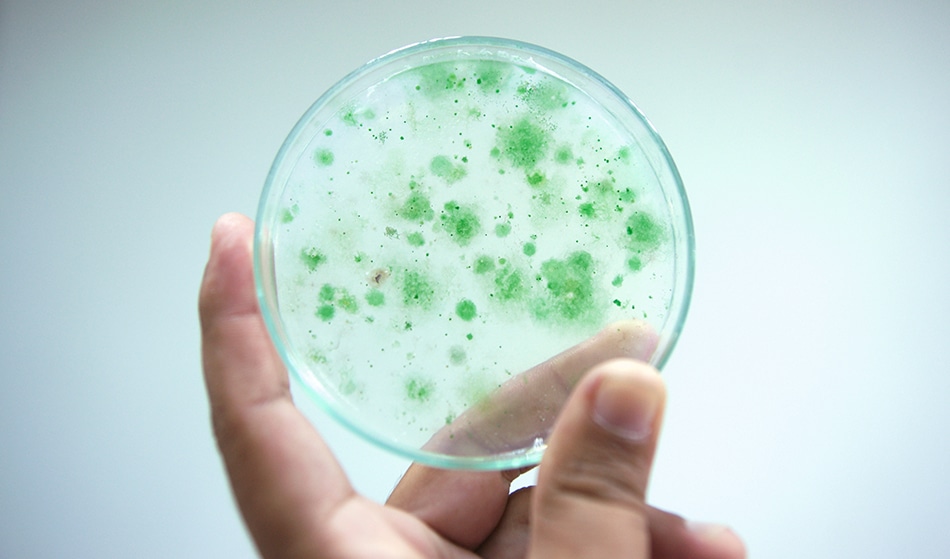 Photo credit: Choksawatdikorn / Shutterstock
Photo credit: Choksawatdikorn / Shutterstock
Cambridge scientists have edged closer to greener fuel cells by designing an algae-powered cell five times more efficient than existing plant and algal model. The model also offers the potential to be more cost effective and practical to use.
The demand on energy is ever-increasing as the global population rises, and the threat of climate change means that there is an urgent need to find cleaner, renewable alternatives to fossil fuels. In addition, these alternatives should not contribute to the already massive amounts of greenhouse gases which have potentially devastating effects on our ecosystem.
Solar power is considered a particularly attractive alternative, as on average the Earth receives around 10,000 times more energy from the sun in a given time than is required by human consumption. But harvesting and utilising this efficiently is not easy.
In recent years, biophotopholtaics or BPV – also known as biological solar cells – have emerged alongside synthetic photovoltaic devices as a low-cost, environmentally-friendly means of harvesting solar energy to convert into electrical current. BPV use the photosynthetic properties of microorganisms like algae to convert light to electric current, which can be used to provide electricity.
Algae produce electrons during photosynthesis, some of which are exported outside the cell where they can provide electric current to power devices. So far, all BPVs demonstrated have situated charging (light harvesting and electron generation) and power delivery (transfer to the electrical circuit) in a single compartment; the electrons generate current as soon as they have been secreted.
However, in a new technique described in Nature Energy, researchers from the departments of Biochemistry, Chemistry and Physics at the University of Cambridge have developed a two-chamber BPV system where the two core processes involved in the operation of a solar cell – generation of electrons and their conversion to power – are separate.
“Charging and power delivery often have conflicting requirements,” explains Kadi Liis Saar, of the Department of Chemistry. “For example, the charging unit needs to be exposed to sunlight to allow efficient charging, whereas the power delivery part does not require exposure to light but should be effective at converting the electrons to current with minimal losses.”
Developing a two chamber system allowed researchers to design the units independently and optimise the performance of the processes simultaneously.
“Separating out charging and power delivery meant we were able to enhance the performance of the power delivery unit through miniaturisation,” explains Professor Tuomas Knowles from the Department of Chemistry and the Cavendish Laboratory. “At miniature scales, fluids behave very differently, enabling us to design cells that are more efficient, with lower internal resistance and decreased electrical losses.”
Using algae that had been genetically modified to carry mutations enabling the cells to minimise the amount of electric charge dissipated non-productively during photosynthesis, together with a new design, enables researchers to build a BPV cell with a power density of 0.5 W/m2 - five times that of their previous design. This is still only approximately a tenth of the power density provided by conventional solar fuel cells, but these new BPVs have several attractive features, they say.
"While conventional silicon-based solar cells are more efficient than algae-powered cells in the fraction of the sun’s energy they turn to electrical energy, there are attractive possibilities with other types of materials," says Professor Christopher Howe from the Department of Biochemistry. “In particular, because algae grow and divide naturally, systems based on them may require less energy investment and can be produced in a decentralised fashion."
Separating energy generation and storage components could have other benefits say the researchers. The charge could be stored rather than used immediately meaning charge could be generated during the day and used at night.
It is unlikely that algae-powered fuel cells will generate enough electricity to power a grid system, but they may be particularly useful in areas where sunlight is in abundance but there is no existing electric grid system, such as rural Africa. In addition, whereas semiconductor-based synthetic photovoltaics are usually produced in dedicated facilities away from where they are used, the production of BPVs could be carried out directly by the local community, say the researchers.
“This a big step forward in the search for alternative, greener fuels,” says Dr Paolo Bombelli, from the Department of Biochemistry. “We believe these developments will bring algal-based systems closer to practical implementation.”
Disclaimer: The views expressed here are those of the author expressed in their private capacity and do not necessarily represent the views of AZoM.com Limited T/A AZoNetwork the owner and operator of this website. This disclaimer forms part of the Terms and conditions of use of this website.